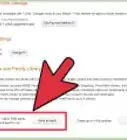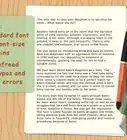X
This article was co-authored by wikiHow Staff. Our trained team of editors and researchers validate articles for accuracy and comprehensiveness. wikiHow's Content Management Team carefully monitors the work from our editorial staff to ensure that each article is backed by trusted research and meets our high quality standards.
There are 7 references cited in this article, which can be found at the bottom of the page.
This article has been viewed 132,636 times.
Learn more...
If you want to send books overseas, you probably don't want to pay more for shipping than you have to. Keep reading for help understanding your packaging and postage options so you can choose what's right for you!
Steps
Method 1
Method 1 of 2:
Choosing Your Shipping Service
-
1Get rate quotes for your package. Look online to compare pricing options from various shippers. Many websites will provide a pricing estimation after you type in your shipping destination and package weight. Many of them will also explain details such as proper package dimensions or rush shipping. You can also contact the shippers to get these estimations.
- Give a rough estimate of the weight of the package. The shipping service will give you a precise estimate when they weigh the package at their shipping center.
-
2Send individual books by envelope. The most common sending option is by envelope. These envelopes often are bought at a flat rate depending on the book’s destination. Some envelopes you can use are already padded. Envelopes feature limited space and if they are overstuffed or too heavy, you’ll have to pay extra.[1]
- In the US, the Priority Mail envelope option is available for books under four lbs. (1.8 kg).
- Size matters. The USPS, for example, will charge you extra if the envelope is uneven or rigid.
Advertisement -
3Upgrade to a box for more space. Boxes offer more protection and come in a variety of sizes. The smallest boxes may carry the same price as an envelope from the post office. Shipping companies such as FedEx and UPS in the US often accept heavier packages. Use these when sending larger books or multiple books.
- The smallest box from the US Postal Service has a weight limit of 4 lbs. (1.8 kg). Larger boxes have a limit of 20 lbs. (9.1 kg). Your post office may not accept boxes heavier than this.
- Consult the shipping company about their box sizes. They will charge extra for packages that don’t fit their standard box dimensions.
-
4Check the post office for an airmail bag option. In the US, for example, the post office offers shipment by M-bag. The M-bag is reserved for print material and can be bought at a flat rate. With the M-bag, you will be charged the same rate for packages up to 11 lbs. (5 kg). If your country offers a similar option, it’s the cheapest way to send books.
- Not all post offices in the US have M-bags available. Call ahead to see where you can find one.
-
5Ship small packages quickly through surface mail. Surface mail means the package travels by land or sea. Most people will use these options because they are cheaper. Envelopes and boxes go by this route and M-bags have the option to do so too. Surface mail is the most inexpensive option for small packages and can often be received within two weeks.
-
6Send large shipments by sea. It’s possible to reserve space in a cargo ship to send larger quantities of books. Contact companies such as Seven Seas Worldwide or AbleCargo. Most countries have this option available and will charge you less than an airmail shipment. Sea travel can be slow, with some shipments taking as long as a few months to arrive![2]
-
7Pick airmail for quick shipments. Airmail is commonly used for speedier delivery. Most post offices and shipping companies offer this option for standard packages. You may also be able to reserve space on an airline. Look for companies with cargo planes or contact a national airline. They may have space for some boxes of books, but it’ll be more expensive than other shipping options.
Advertisement
Method 2
Method 2 of 2:
Getting the Packages Ready
-
1Wrap the book securely. Slip each book in a waterproof bag first. Secure the book in bubble wrap. If you are shipping multiple books, you may be able to package them together. Make sure the wrapping is tight so the book stays secure. The extra padding can prevent damage during handling.[3]
-
2Select your box or envelope size. Consult with the company to find out what box sizes they allow. Make your boxes as small and flat as possible in order to save space and money. FedEx, for example, has a 10kg box for shipments up to 22 lbs. and a 25kg box for shipments up to 56 lbs. Seal the box with packing tape.[4]
- Most companies will provide shipping material. If you bring your own, make sure the box or envelope is sturdy.
-
3Weigh the package. Look over the package to make sure it looks secure and ready to go on its journey. Place it on a scale. Most post offices and shipping companies will do this for you and enter the weight into their system. An improperly-weighed box can incur charges that you or the recipient will have to pay later.[5]
- Splitting up heavier packages may save you on shipping expenses. Calculate how much it would cost you to send two packages instead of one heavy one.
- For an M-bag, for instance, the bag shouldn’t weigh more than 66 lbs (30 kg), including the sack.
-
4Label the box with the shipping and return address. No matter how you ship the books, they need to be labeled. Shipping labels can be found online and printed. Many post offices also have them, and shipping companies will often put them on for you. Fill out one with your name and address in the upper left corner. Mark the center of the label with the recipient’s name, address, city, and country. Write clearly and in capital letters.
- When shipping via M-bag, you’ll need to fill out another address label to place on the bag.
-
5Complete the customs form. All international shipping has to be documented. Post offices stock these forms and most shipping companies will complete the documentation for you. In the US, for example, you’ll probably need the #2976 form. In the UK, this may be the CN22 form. Fill out the form as accurately as possible. You will need to state what you are sending and possibly other details, like what the books are made of.[6]
- These forms can be found online and filled out at home. Post offices and shipping companies also stock them.
- The post office or your local government can answer any questions you have.
-
6Decide who pays import duties. Sometimes, delivery costs more than expected. A country may charge a tax for the package, which can be a surprise to the person receiving it. Have the shipping company calculate the expense for you. It’s up to you to work with the package recipient to decide how to split extra charges.[7]
Advertisement
Community Q&A
-
QuestionHow much would it cost to ship one average sized book from the US to Australia?
 Community AnswerYou could wrap the book and place it in a flat rate envelope. These can currently be sent for about $24. With shipping costs, it would come out to about $34. You can pay more to rush the shipment or for a larger box.
Community AnswerYou could wrap the book and place it in a flat rate envelope. These can currently be sent for about $24. With shipping costs, it would come out to about $34. You can pay more to rush the shipment or for a larger box. -
QuestionHow much does it cost to send one average sized book from the US to France?
 Community AnswerGet the weight and dimensions of the book. Go online to a shipping company's website, like FedEx or DHL. Enter the weight and dimensions and the destination address and they will give you a quote.
Community AnswerGet the weight and dimensions of the book. Go online to a shipping company's website, like FedEx or DHL. Enter the weight and dimensions and the destination address and they will give you a quote. -
QuestionHow do I find out how much it will cost to ship my books to a specific country?
 Community AnswerAll shipping costs will vary depending on the carrier chosen, the weight of the books, and the country/destination. One needs to contact individual shippers and compare.
Community AnswerAll shipping costs will vary depending on the carrier chosen, the weight of the books, and the country/destination. One needs to contact individual shippers and compare.
Advertisement
Things You'll Need
- Shipping sticker
- Packing tape
- Envelope or box
- Waterproof plastic sack
- Bubble wrap
- Customs form
- Pen or marker
References
- ↑ https://www.usps.com/international/priority-mail-international.htm
- ↑ http://www.sevenseasworldwide.com/en-us
- ↑ https://www.usps.com/international/preparing-international-shipments.htm
- ↑ https://smallbusiness.fedex.com/international/flat-rate/guide
- ↑ http://www.iosart.com/misc/m-bags.html#forms
- ↑ http://www.postoffice.co.uk/mail/international-standard
- ↑ https://www.ups.com/us/en/help-center/shipping-support/how-to-ship-internationally.page
About This Article
Advertisement








































































